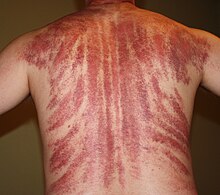Coining therapy, also known as Gua Sha or Cao Gio, is an ancient Chinese practice of alternative medicine that is still practiced today. The term Gua Sha literally translates into “scraping away fever.” The procedure is used when a patient is suffering from pain and illnesses, such as cold, flu, chronic pain, fatigue, or headaches. Heated oil is rubbed onto the patients back, chest, shoulders, or neck and a round object, such as a coin is rubbed or scraped across the area until red marks appear.
It is the belief that bad energy and toxic heat can be scraped away. Coining will bring the blood to the surface so that negative energy can be released. Additionally, it is believed that this method will promote Qi (positive energy) and blood circulation. The color of the markings indicates the patient’s blood stasis with is believed to correlate with nature.
There are some complications to this procedure. Minor burns, bruising, bleeding can occur. Marks should typically fade in several days to a week. Additionally, parents who use the coining therapy on children have been accused of child abuse.
There are no studies done or any conclusive evidence to indicate the effectiveness of coin therapy; however many people claims and believe it to be successful. While the procedure might bring short term relief, the long term effectiveness remains unknown.
Personal Opinion:
I have gotten the coining procedure done once when I had a fever. Tiger balm was applied to a buffalo horn and it was repeatedly scraped across my back to mimic the stripes of a tiger. After 30 minutes, it was complete and I had markings down my entire back, which took roughly a week to fade.
I’d probably never do it again because it was very painful. Additionally, I’m unsure whether or not the procedure was effective. While I did feel better the day after the treatment, I am not completely convinced that it was due to the treatment. I was also taking antibiotics at the same time, which could have been responsible in making me feel better. I would also assume that the placebo effect plays a large role; people perceive the coining method as an effective healing method, when in fact it may not have worked.
Sources:







Wow! This looks so painful! I cannot believe that this is still put into practice. Since there is no concrete scientific proof that this treatment works, it definitely seems a bit far-fetched. I agree with your comment about the placebo effect coming into play. I definitely think that the placebo effect has a role in how people feel better. Even though I find it hard to believe anyone can feel better with markings like that on their back.
ReplyDelete